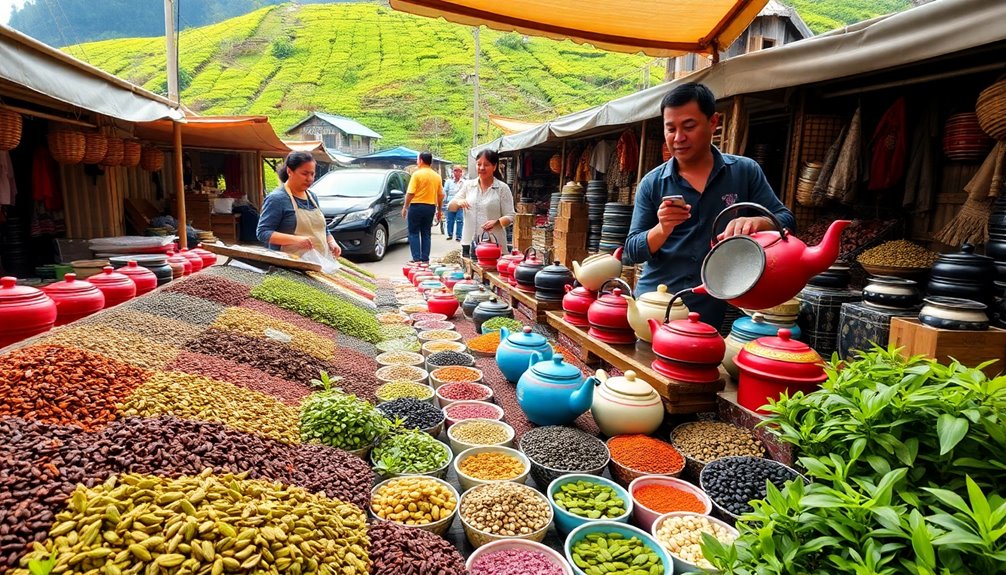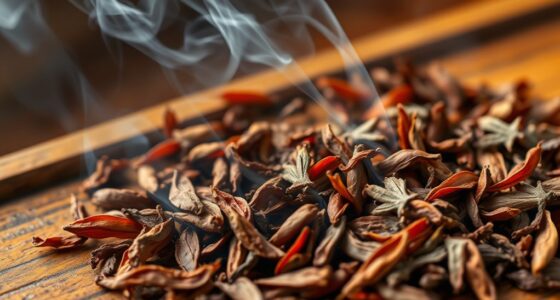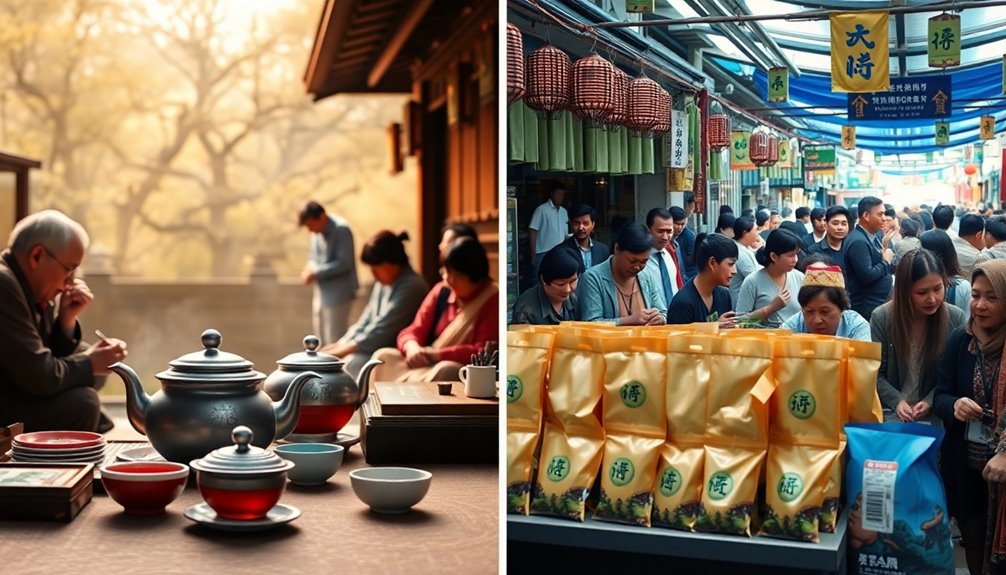Tea varieties originate from various regions around the world, each boasting unique flavor profiles and cultivation methods. For instance, Yunnan in China is known as the birthplace of tea, while Assam and Darjeeling in India produce distinct malty and floral teas, respectively. Japanese green teas are celebrated for their hand-harvesting techniques, and Kenyan teas thrive in volcanic soils, offering robust flavors. These regional characteristics stem from local traditions and climates that influence tea production. By exploring these origins further, you can discover more about the rich tapestry of tea culture and its global significance.
Key Takeaways
- Assam tea, known for its strong, malty flavor, originates from the Assam region in India.
- Darjeeling tea, often called the "Champagne of teas," is cultivated in the Darjeeling district of India.
- Ceylon tea, characterized by its bright, citrusy taste, comes from Sri Lanka, specifically the highlands.
- Kenyan black tea, recognized for its full-bodied flavor, is produced in high-altitude regions of Kenya.
- Chinese green teas, such as Longjing, are primarily grown in the Hangzhou region of China, known for delicate, vegetal notes.
Introduction

Tea has a rich tapestry of history and culture that spans the globe. The journey of tea begins in the Yunnan province of China, considered the birthplace of tea cultivation. Here, you'll discover the origins of various tea varieties, each with unique flavors and characteristics. Chinese tea laid the foundation for what would become a global phenomenon.
As you explore further, you'll find that Japanese tea was introduced in the 9th century by Buddhist monks who brought seeds from China. This laid the groundwork for distinct Japanese tea varieties, which are now celebrated for their delicate flavors.
Meanwhile, Indian tea, particularly black tea from regions like Assam and Darjeeling, has made a significant mark, contributing about 25% of the world's supply.
Don't overlook Taiwanese teas, such as Dong Ding and Oriental Beauty, which are renowned for their rich flavors, shaped by traditional cultivation methods.
In Africa, Kenyan tea stands out with its vibrant color and full-bodied taste, thriving in high altitudes and volcanic soils. Together, these regional specialties create a diverse tea market, showcasing the beauty and complexity of tea cultivation and processing methods worldwide.
Tea's Ancient Cultural Significance

Throughout history, tea has played a pivotal role in shaping cultural practices and social rituals across various societies. In China, legend credits Emperor Shen Nong with discovering tea in 2737 B.C.E., recognizing its medicinal properties as he researched herbs.
During the Tang Dynasty (618-907), tea culture flourished, leading to widespread consumption and the establishment of a government tea tax, highlighting its economic significance.
In Japan, Buddhist monk Saichō introduced tea in the early 9th century, cultivating it in monasteries, which underscored tea's spiritual and cultural importance within Japanese society.
Traditional Japanese tea ceremonies evolved, reflecting the aesthetics influenced by Buddhist, Taoist, and Confucian beliefs. These rituals emphasize mindfulness, community, and appreciation for the present moment.
Lu Yu's treatise "Cha Ching" from the 8th century further enriched the history of tea by detailing various types, including Chinese green and Japanese teas, along with preparation methods and health benefits.
This comprehensive understanding of tea processing solidified its place in both Chinese and Japanese culture, making it a cherished beverage with a rich history that continues to influence societies today. Additionally, the health benefits of ginger lemon tea illustrate how tea blends can enhance overall wellness and reflect diverse cultural practices.
Tea's Role in Trade History

From its early days as a luxury commodity to its widespread popularity today, tea has significantly influenced global trade dynamics. The British East India Company emerged in the 1700s as a dominant force in the tea trade with China, leveraging its power to control trade routes and expand British imperial influence. Initially, tea consumption was limited to the royal and aristocratic classes in Europe, fostering a luxurious reputation that drove demand.
In the mid-1600s, tea made its way to America through Dutch New Amsterdam, but heavy tea taxes imposed by the British East India Company sparked protest, culminating in the Boston Tea Party.
As clipper ships revolutionized the tea trade in the 1850s, faster importation from China led to fierce competition among traders for high-quality teas.
The repeal of Navigation Acts allowed direct tea importation to America, transforming tea drinking into a significant social pastime by the 19th century. This surge in popularity spurred innovations like iced tea and the commercialization of tea bags, forever changing how you enjoy this beloved beverage.
Tea's role in trade history reflects its incredible journey from luxury to everyday enjoyment.
Regional Tea Cultivation Techniques

As tea's influence on trade expanded globally, its cultivation adapted to diverse environments, resulting in a rich variety of flavors and practices.
In Japan, for instance, you'll find that hand-harvesting the youngest leaves is essential for producing the distinct flavors of Japanese green teas. The steaming or pan-firing methods employed here preserve those unique characteristics that set them apart.
Meanwhile, Chinese tea production relies on meticulous hand-plucking of top leaves and buds. The various processing techniques, such as oxidation and artisanal fermentation, create an impressive range of tea types, each with its own personality.
Taiwanese teas, like Dong Ding, highlight the importance of artisanal fermentation and hand-picking, enhancing their floral and honeyed notes.
In contrast, Kenyan teas often utilize mechanical harvesting, allowing for large-scale production. This method takes advantage of high altitudes and volcanic soils, which contribute to the vibrant flavors that Kenyan teas are known for.
Each region's approach to tea cultivation and processing techniques not only reflects local traditions but also leads to the remarkable diversity found in the world of tea.
Sustainability in Tea Production

Sustainable tea production is increasingly vital in today's world, where environmental concerns are at the forefront of consumer choices. You'll find that many tea producers are adopting sustainable tea production practices to minimize their environmental impact.
Organic farming methods, which avoid synthetic fertilizers and pesticides, promote biodiversity and create healthier ecosystems in tea-growing regions. Additionally, agroforestry techniques integrate tea cultivation with tree planting, enhancing carbon sequestration and improving soil health, while providing habitats for wildlife.
Certifications like Fair Trade and Rainforest Alliance play a crucial role in this movement. They ensure farmers receive fair wages, work under safe conditions, and adhere to eco-friendly practices, helping to support local communities.
Water conservation is another critical aspect of sustainable tea production. Farmers utilize techniques such as rainwater harvesting and drip irrigation to minimize water usage, further reducing their environmental impact.
With the global market for organic tea projected to grow significantly, it's clear that consumer demand for sustainably sourced products is rising. By embracing these practices, you can contribute to a more sustainable future while enjoying your favorite tea. Additionally, many consumers are turning to herbal teas for their health benefits and environmental sustainability, making them a popular choice in this movement.
Practical Applications

Understanding the practical applications of different tea varieties can enhance your tea-drinking experience and guide you in making informed choices. By recognizing the unique characteristics of each variety, you can select the perfect tea for any occasion.
For instance, if you're in the mood for a bold, malty flavor, Assam's rich profile is ideal, while Darjeeling offers delicate, floral notes that are perfect for a light afternoon refreshment.
When exploring Chinese green teas, such as Longjing, you'll appreciate its nutty flavor and vibrant color, thanks to its pan-firing processing. On the other hand, Japanese teas like Sencha and Matcha bring a fresh, umami experience, with Sencha's steaming method preserving its taste.
Don't overlook Sri Lankan Ceylon tea, known for its bright, brisk flavor, which thrives in high-altitude regions. The elevation here significantly influences tea's taste profile, delivering a unique experience.
Similarly, Kenyan black tea boasts a full-bodied taste due to its volcanic soil and climate. By understanding these elements, you can better appreciate each tea variety and tailor your choices to suit your preferences and occasions.
Conclusion
In exploring the regional origins of popular tea varieties, you've uncovered the deep cultural significance and rich history behind each cup. You've seen how local cultivation techniques and sustainable practices shape the tea you enjoy today. By appreciating these factors, you not only enhance your tea-drinking experience but also support responsible production methods. So next time you sip your favorite blend, remember the journey it took and the stories woven into its leaves. Enjoy every moment!










